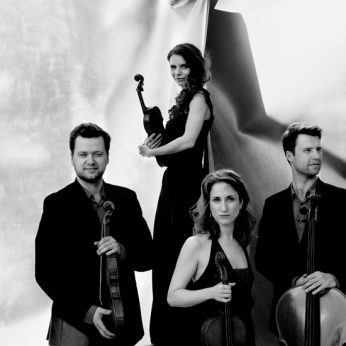Composer: Leoš Janáček (b. 1854 - d. 1928)
Performance date: 28/06/2023
Venue: St. Brendan’s Church
Composition Year: 1928
Duration: 00:25:29
Recording Engineer: Gar Duffy, RTÉ
Instrumentation: 2vn, va, vc
Instrumentation Category:String Quartet
Artists:
Armida Quartet (Martin Funda, Johanna Staemmler [violins] Teresa Schwamm [viola], Peter-Philipp Staemmler [cello]) -
[String Quartet]

Quartet No.2 ‘Intimate Letters’ [1928]
1. Andante
2. Adagio
3. Moderato
4. Allegro
Janáček’s Second Quartet invites us into the torrid imagination inspired by the seventy-year-old composer’s unrequited relationship with Kamila Stösslova. She was, and remained, a happily married mother of two when the composer transformed her into his creative Muse. He interrupted his work on From the House of the Dead for three weeks to write this erotic celebration of love. It is a daring work not least in his experiments with different timbre, particularly with tremolo and sul ponticello. He replaces strict formal models with a structure of momentum and suspension; traditional development is taken over by swirling juxtapositions of themes representing dramatically contrasted moods. Above all he wrote a work that seduces both audiences and musicians
From the first bar the music bursts into flames with a passionate theme, which will recur throughout the four movements. My feelings when I saw you for the first time, wrote Janáček to Kamila. The first eight bars give way to a viola solo played sul ponticello; Janáček had for a time been obsessed with replacing the viola with a viola d’amore, seemingly attracted by the name of the instrument as much as its sound. The sul ponticello effect was his superb solution and quartet violists have been saved from the ignominy of being replaced by a baroque instrument.
Today I set to music my tenderest desire. I fought with it. It prevailed. It was like a birth. What would the destiny of this son have been – simply as we are, passing from tears to laughter? The viola opens the extraordinary second movement with a gentle lullaby theme, which slowly expands into music of extreme exaltation. This is eventually interrupted by a few short scales descending flautato, which usher in a presto popular dance theme, before bringing back the viola theme from the first movement. The flautato scales are then used again to signal the reappearance of these various ideas before the movement ends suddenly.
Today I wrote the number where the earth trembles. It will be the best. The third movement begins with a swaying barcarole. The central adagio section shifts to mysterious harmonies played very softly; a magnificent contrast occurs when the same music returns fortissimo, played by the violin at full stretch and transfigured by a C major chord. The barcarole is brought back at several different tempos and there is a reminder of the mysterious central adagio before the movement ends suddenly with three cries. The last movement follows immediately, a rondo with a spirited dance refrain. The first episode again recalls the work’s opening theme in four trilled notes. The second episode is marked andante, and again calls up the four-note theme, furioso sul ponticello. The momentum is built up before an abrupt close.
Francis Humphrys
Copyright © 2025 West Cork Music. All rights reserved.
Designed and developed by Matrix Internet